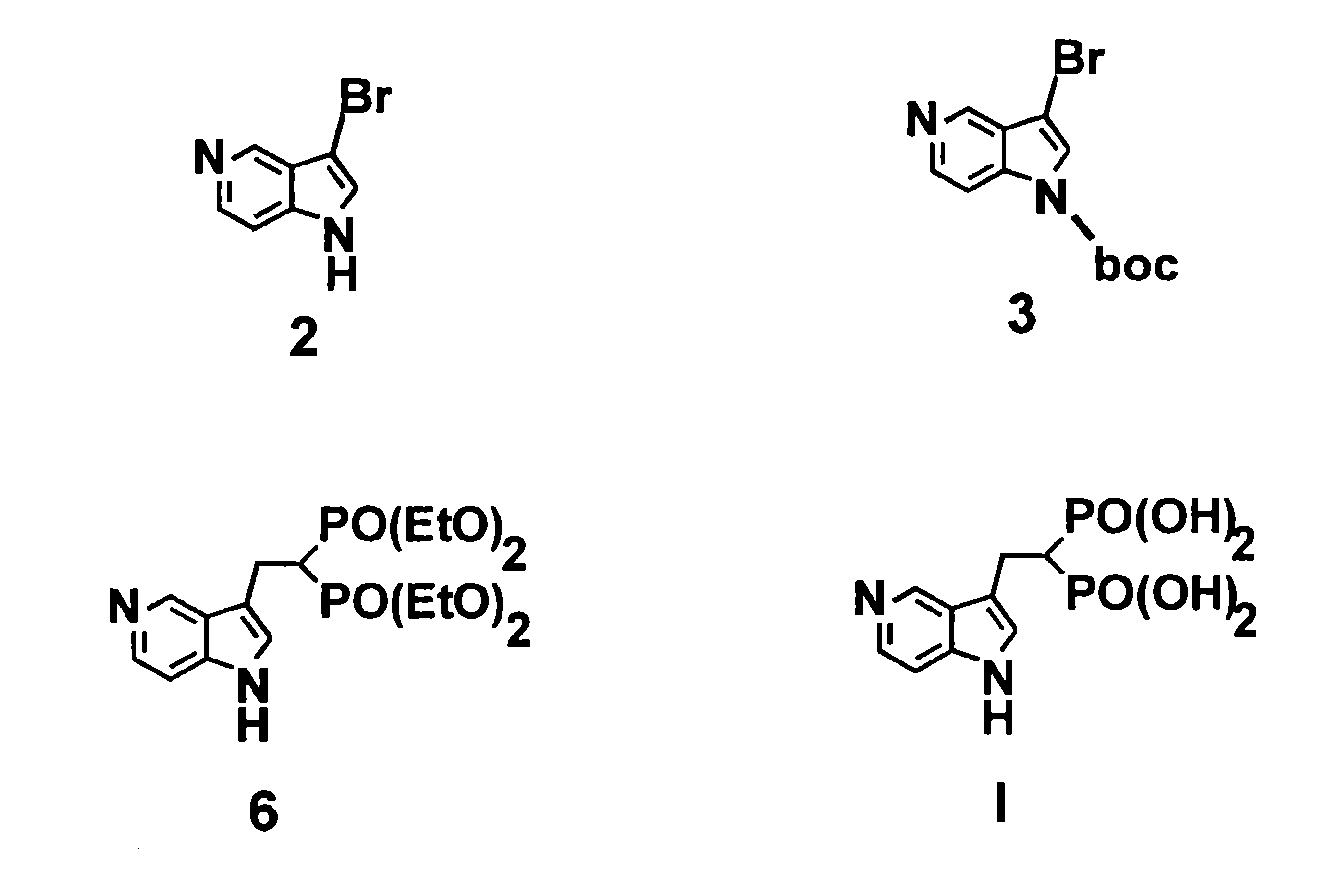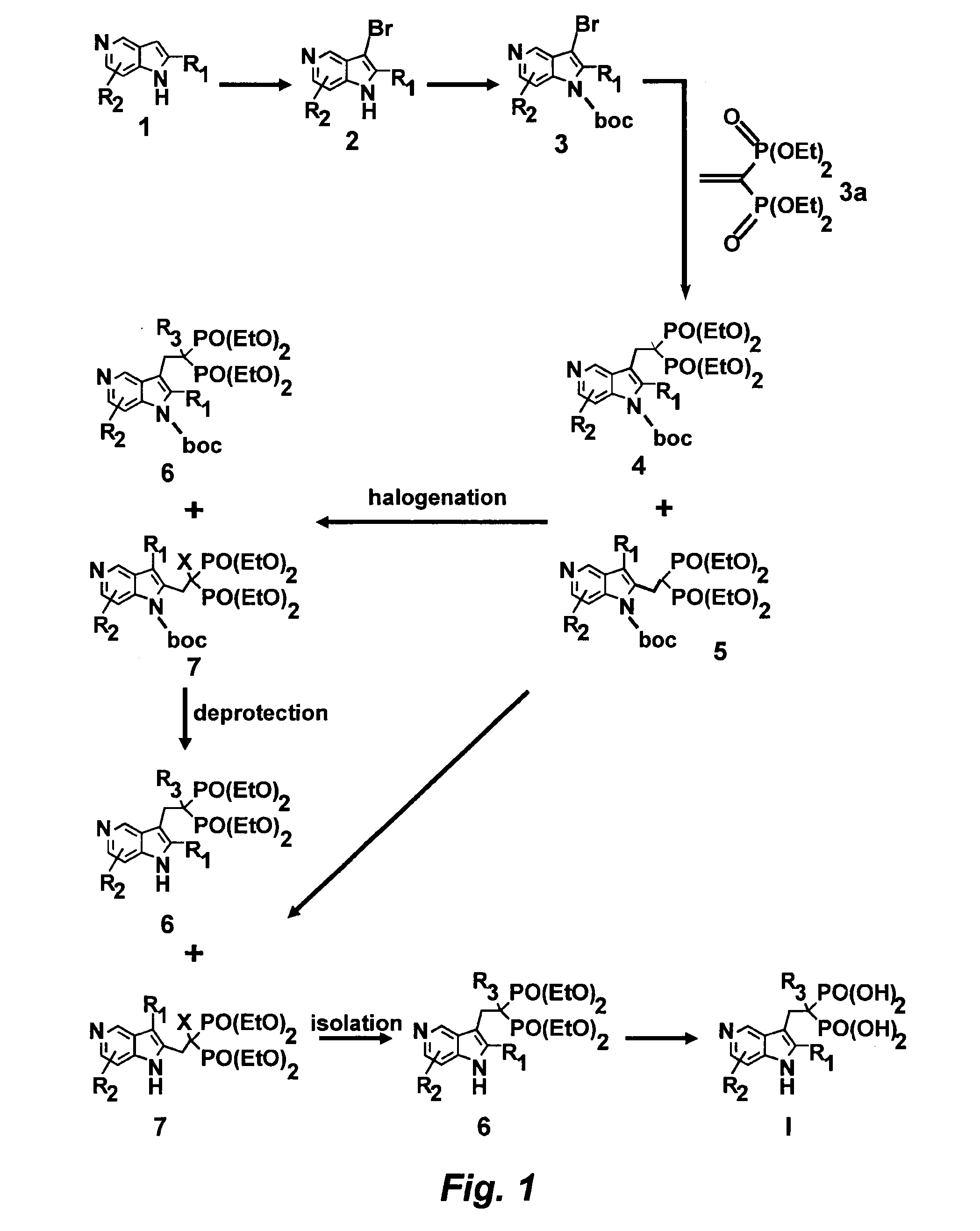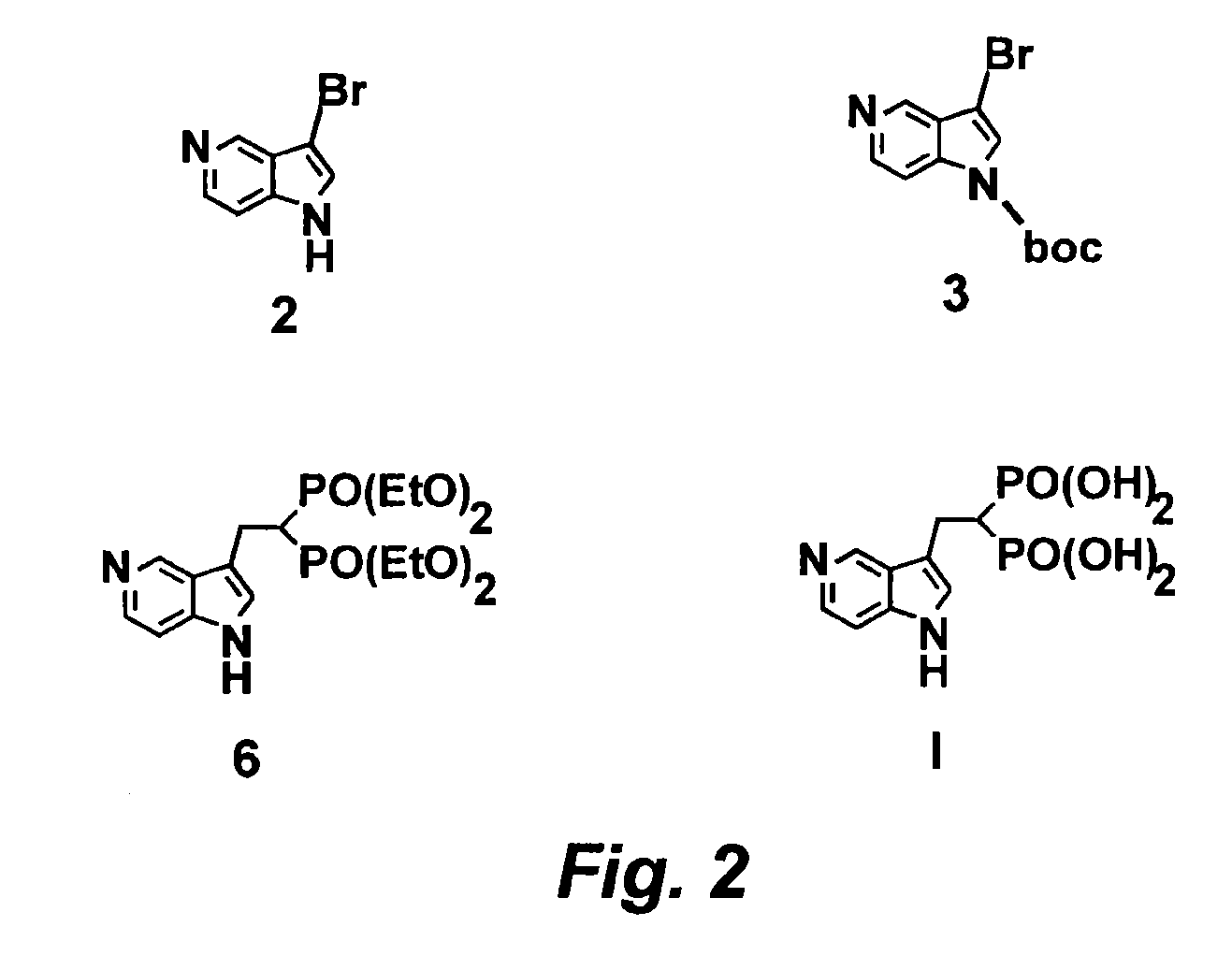5-azaindole bisphosphonates
a technology of azaindole and bisphosphonates, applied in the field of 5azaindole bisphosphonates, can solve the problems of reducing bone strength, reducing bone density, and reducing bone density, so as to prevent the loosening of prostheses and inhibit the resorption of bone tissu
- Summary
- Abstract
- Description
- Claims
- Application Information
AI Technical Summary
Benefits of technology
Problems solved by technology
Method used
Image
Examples
example 1
3-bromo-5-azaindole
[0145]Referring now to the Scheme 1 as shown in FIG. 1, a solution of 3.0128 g (25.51 mmol) of 5-azaindole (Atlantic SciTech Group) in 50 mL of acetonitrile was placed in a 250 mL three-neck round-bottom flask equipped with a magnetic stirrer, thermocouple, nitrogen bleed, and cooling ice bath. A total of 17.10 g (76.53 mmol, 3 eq.) of solid CuBr2 was added portion-wise to the flask at 17° C. in 10 min. The resulting green suspension was stirred at room temperature until no starting material was observed by TLC (approximately 1-2 hours, Rf=0.23 for 5-azaindole and 0.49 for 3-bromo-5-azaindole in EtOAc / MeOH=9:1). The reaction mixture was cooled to 10° C. and then was slowly quenched by addition of 7N ammonia in methanol solution (110 mL). The resulting blue solution was concentrated on rotavap at room temperature, and the residue was extracted with ethyl acetate (3×80 mL). The organic extract was dried over Na2SO4, filtered, and concentrated to residual volume of a...
example 2
N-BOC-3-bromo-5-azaindole
[0146]Referring now to the Scheme 1 as shown in FIG. 1, a solution of 3.5601 g (18.06 mmol) of 3-bromo-5-azaindole (2) and 0.4651 g (3.8 mmol, 21 mol %) of dimethylaminopyridine (DMAP) in 80 mL of THF was placed in a 250 mL three-neck round-bottom flask equipped with a magnetic stirrer, thermocouple, nitrogen bleed, and cooling ice bath. A total of 4.7769 g (21.88 mmol, 1.2 eq.) of BOC2O was added to the flask at 17° C., and the resulting mixture was stirred until starting 3-bromo-5-azaindole disappeared, as monitored by TLC (generally, overnight stirring at room temperature). The resulting yellow solution was concentrated on rotavap, washed with 100 mL of saturated sodium bicarbonate, and extracted with dichloromethane (3×80 mL). The organic phase was dried over Na2SO4 and concentrated on rotavap to afford 6.57 g of orange solid. This crude material was purified on CombiFlash using hexane / ethyl acetate as eluent to give 5.25 g (97% yield) of n-boc-3-bromo-5...
example 3
Tetraethyl-5-azaindol-3-yl-ethyl-bisphosphonate
[0147]Referring now to the Scheme 1 as shown in FIG. 1, a solution of 2.9138 g (9.805 mmol) of N-boc-3-bromo-5-azaindole in 50 mL of anhydrous THF was placed in a 250 mL three-neck round-bottom flask equipped with a magnetic stirrer, thermocouple, nitrogen bleed, and cooling dry ice / acetone bath. A total of 4.3 mL (10.75 mmol, 1.1 eq.) of 2.5N solution of n-butyl lithium in hexane was slowly added to N-boc-3-bromo-5-azaindole with the rate to maintain the reaction temperature below −73° C. The resulting orange-colored solution stirred at −73° C. for 30 min, and a total of 2.9485 g (9.82 mmol, 1 eq.) of vinyl bisphosphonate, tetraethyl ethane-1,1-bisphosphonate (prepared according to the procedures given in J. Org. Chem. 1986, 51, 3488-3490, incorporated herein by reference in its entirety) was slowly added and after stirring at −73° C. for 20 min the resulting mixture was allowed to warm to room temperature. The reaction was quenched wi...
PUM
| Property | Measurement | Unit |
|---|---|---|
| temperature | aaaaa | aaaaa |
| temperature | aaaaa | aaaaa |
| pH | aaaaa | aaaaa |
Abstract
Description
Claims
Application Information
 Login to View More
Login to View More - R&D
- Intellectual Property
- Life Sciences
- Materials
- Tech Scout
- Unparalleled Data Quality
- Higher Quality Content
- 60% Fewer Hallucinations
Browse by: Latest US Patents, China's latest patents, Technical Efficacy Thesaurus, Application Domain, Technology Topic, Popular Technical Reports.
© 2025 PatSnap. All rights reserved.Legal|Privacy policy|Modern Slavery Act Transparency Statement|Sitemap|About US| Contact US: help@patsnap.com



